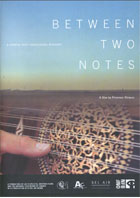
Between Two Notes (French title: Le Blues de l'Orient) 2006
Distributed by National Film Board of Canada, 1123 Broadway, Suite 307, New York, NY 10010; 800-542-2164
Produced by Serge Lalou, Amit Breuer, Colette Loumède, and François Duplat
Directed by Florence Strauss
DVD, color, 85 min.
College - Adult
Music, Middle Eastern Studies, Jewish Studies
Date Entered: 01/22/2008
Reviewed by Bonnie Jo Dopp, Performing Arts Library, University of MarylandThis musical exploration of cultural heritage and displacement features mainly Jewish musicians who perform Arabic music on traditional Arab instruments. Florence Strauss’s own Jewish grandfather was born in Egypt but was forced to leave; her film is an homage to Jews who love and have mastered ancient Arab musical practice. Iraqi Jews who settled in Israel sing of "the lost earth of their childhood” in home ‘music salons’ where even after four decades, they continue to argue in Hebrew and Arabic over fine points of performance. They and others make persuasive arguments for understanding how Arabic traditional Mid-East Jewish musical culture is, and how important remembering this is and has been both for individuals who have felt ostracized and for young people who otherwise may be kept from learning the riches of Arabic tradition, in both religious and secular music.
Jewish musicians in several Mid-East countries speak in French, English, Arabic, and Hebrew of how Arab music informs their identity. The film lingers long on individual songs, chants, and instrumental pieces. The French title reflects the seriousness and sadness reflected in the music featured here; the English title refers to the musical quarter-tones available to these musicians: notes “between” the half-steps of the Western chromatic scale. The idea of music-across-borders and of peacemaking through cultural understanding is reiterated throughout. Hopeful notes include Arabic music being taught in a Jerusalem conservatory and a performance from a group of mixed-religious young musicians who are interested in promoting this music even as they add their own licks to it.
The DVD menu is not immediately apparent when the disc is first inserted in a player and it takes some exploration to discover that it can be played in either a French or English version (with appropriate subtitles). Old film and television clips of performers make their points, but viewers will mainly appreciate lush photographic images of present-day places (Cairo, Tell Aviv, Beirut and more) and good audio presentations of contemporary performances.
Teachers of both Jewish and Arab studies might find a use for this program, but graduate ethnomusicology seminars on Middle-Eastern music are probably the best educational fit for its content.